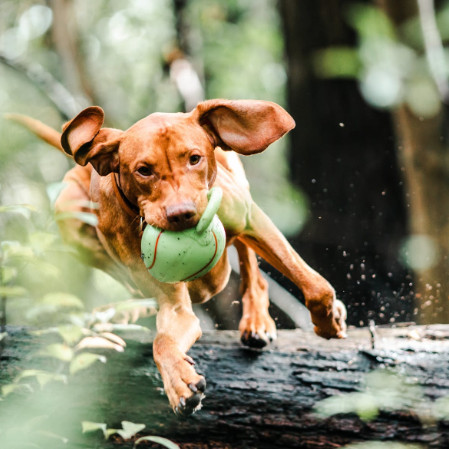Laurie's Blogs.
Aug 2020
Survey Responses - Canine Return to Sport Testing

Last week’s blog, https://www.fourleg.com/Blog/471/Testing-for-Return-to-Sport was well received. Within it, I posted a link to a survey asking others for their ideas on the topic. This week’s blog is the response to those questions! Enjoy the read and thought processing on how we can guide canine athletes back into sports safely!
1. What specific physical measures would be important for return to sport?
(i.e. in regards to ROM, Weight bearing, Effusion, Thigh Circumference, or other passive measures.)
Full PROM flexion/extension,
Fairly close symmetry in weight bearing in stance on stance analyzer and with gait visually,
Thigh circumference similar to other leg,
Proper tucked sit and down (especially for agility where those positions are required/used),
Weight bearing
Functional rom (limbs and spine) - dynamic control through full functional rom
Proprioceptive accuracy of limb placement (at speed/impact of required in specific sport)
Dynamic stability of the joint (e.g. stifle) under expect load
No early fatigue of a limb during activity (time scale, as required for specific sporting activity)
2. What tests would you include to determine adequate strength in a post-operative or injured limb for return to sport?
(i.e. Considerations for how to compare limb strength to the contralateral limb? Abilities? Other?)
Lateral steps,
Kick back,
Jumps at different heights,
Jump from an instable surface to a stable one (from disc or k9fit one to table),
Stand with front limb elevated
Symmetric strength when loaded tested via opposite/same side leg raises/standing on an unstable surface such as a bosu,
Symmetric push off and turns seen in clinic or via video of sport movements
To assess power and dynamic stability:
Video analysis of activities where increased power required (walking upstairs, box jumping, execution of tight turns at speed)
Fatigue point of post-op/injured limb:
Measure time until visible gait asymmetry/compensatory gait, e.g. on TM/ uphill TM.
3. What functional capabilities would you consider to be important in determine a dog's return to sport readiness?
(i.e. No lameness when fatigued. No lameness after cutting and turning drills. Other?)
No lameness/soreness after limb has been challenged through session of sport related activities.
Square sit and down,
No lameness after major sport skills
Proprioceptive accuracy at speed,
Dynamic control at speed and when turning,
Symmetrical functional range of motion of limbs and spine
No gait asymmetry or compensatory gait after max exercise (time/intensity) as required for the specific sport
4. How might you assess proprioception and/or body awareness to determine fitness for return to sport?
(i.e. Timed plank exercise, 1-leg slides, backwards walking over obstacles, other?)
Walking on cavallettis at elbow height very slowly,
Turn 180 degrees on cavallettis
Cavalettis forwards and backwards,
Perch work,
Jump work,
Assessment of form, abilities, and timing with exercises such as jump up plyometrics/sit squats/ipsilateral standing/standing and walking on unstable surfaces/handstand walkouts/planks etc.
Video analysis of activities as required for sport - count proprioceptive errors and compensatory maneuvers (e.g. trot over grid of raised poles - count number of clipped poles or skips)
5. Any other comments or suggestions you would like to make?
No muscle secondary issues or fascial tension
I try to mimic sport related movement patterns and activities in my return to sport programs and if a dog is struggling at all with any of it, dog is not ready for higher level.
I've recently tried to work out the answers for these sorts of questions for a foster dog of mine, he is at the later stages of recovery from a cruciate injury (conservative management as his injury was already 6-8 months old when he came to me) - to try and establish his readiness for higher impact activities. Proprioceptive accuracy, video in slo-mo essential to spot errors in foot placement Power - observing walking up steps/stairs, how many steps does he navigate with symmetrical gait? dynamic stability - video when running/turning in slo-mo, does the stifle 'give way' under load Symmetrical functional range of motion - video of walk/trot, took stills at certain points during gait cycle and compared left/right Fatigue point - observed gait for signs of asymmetry or compensation during everyday activities at moderate intensity (uphill walking, uphill trotting) Last thought... completely non-scientific: I think the narrative that a cruciate injury is "fixed" with surgery and rehab is misleading, as the joint never 'returns' to its pre-injury state. So maybe a dog is safer to return to high intensity activities/sport if they are enabled to develop excellent body awareness and integrate their persistent functional deficits into the expected performance. Maybe we shouldn't aim for just a single-track rehab approach focusing on meeting targets for the injured limb to clear them to return to sport. But widen the brief instead and develop strategies how we accept and monitor persistent functional deficits, and enable the dog perform optimally - ideally with a near- "normal" gait but permit compensatory strategies if these are safer and serve to prevent overloading of the previously injured joint when necessary.
There you go! From here, I think that I'm going to create a checklist of things that I think should be tested for return to sport at my clinic, based on the equipment we have available and/or categorized into different types of conditions that we are rehabbing. That's just what I'm thinking to do with this information. I'd encourage you to do the same!
(Yes, I'll likely share whatever I create with FourLeg Members, not to worry!)
All the best on doing great things in your week ahead!
Cheers! Laurie


